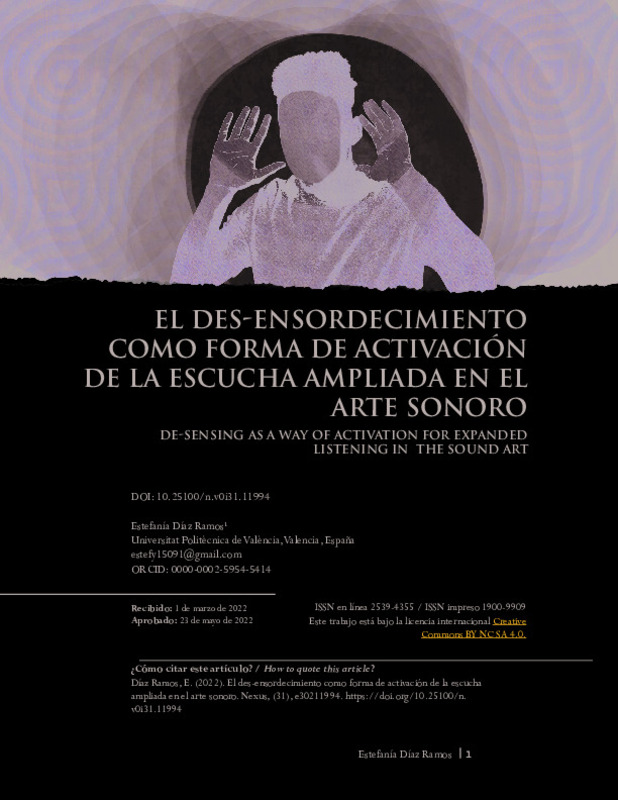JavaScript is disabled for your browser. Some features of this site may not work without it.
Buscar en RiuNet
Listar
Mi cuenta
Estadísticas
Ayuda RiuNet
Admin. UPV
El des-ensordecimiento como forma de activación de la escucha ampliada en el arte sonoro
Mostrar el registro sencillo del ítem
Ficheros en el ítem
| dc.contributor.author | Díaz-Ramos, Estefanía
|
es_ES |
| dc.date.accessioned | 2023-11-22T19:02:47Z | |
| dc.date.available | 2023-11-22T19:02:47Z | |
| dc.date.issued | 2022-06-30 | es_ES |
| dc.identifier.uri | http://hdl.handle.net/10251/200135 | |
| dc.description.abstract | [EN] The continuous naturalization of environmental sounds developed through selective listening has contributed to different processes of sensory training, which define as noise anything that disturbs or prevents a quick and inattentive transit, in a world that discards contemplation. Faced with this systematic deafening, processes of expanded and empathetic listening emerge from sound art. These processes are related to the activation of the perception of those soundscapes, stories and narratives that have been discarded. This brief text aims to investigate some of the ways in which sound art hs confronted the silencing of the environment. Thus, through the concept of de-sensing, the idea is to explore how different sound strategies contribute to destabilize the neutralization of social ear. The concept opens the door to a set of hybrid productions that challenge selective listening and sonically validate the noise that transforms our dwelling in the world. | es_ES |
| dc.description.abstract | [ES] La continua naturalización de los sonidos del entorno desarrollada por medio de una escucha selectiva ha contribuido con diferentes procesos de adiestramiento sensorial, que identifican como ruido a todo aquello que moleste o impida un tránsito rápido y desatento, en un mundo que descarta la contemplación. Frente a este ensordecimiento sistemático, en el campo del arte sonoro emergen procesos de escucha ampliada y empática, relacionados con la activación de la percepción de aquellos sonidos, paisajes, relatos y narrativas descartadas. Este breve texto busca indagar sobre algunas formas en las que la plástica sonora se ha enfrentado al silenciamiento del entorno. Así, a través del concepto de des-ensordecimiento se pretende reflexionar sobre cómo diferentes estrategias sonoras aportan a la desestabilización de un oído social neutralizador; abriendo la puerta a un conjunto de producciones híbridas que cuestionan la escucha selectiva y validan sonoramente aquel ruido que transforma nuestro habitar en el mundo. | es_ES |
| dc.language | Español | es_ES |
| dc.publisher | Universidad del Valle | es_ES |
| dc.relation.ispartof | Nexus Comunicación | es_ES |
| dc.rights | Reconocimiento - No comercial - Compartir igual (by-nc-sa) | es_ES |
| dc.subject | Escucha | es_ES |
| dc.subject | Des-ensordecimiento | es_ES |
| dc.subject | Arte sonoro | es_ES |
| dc.subject | Comensalidad reflexiva | es_ES |
| dc.subject | Listening | es_ES |
| dc.subject | De-sensing | es_ES |
| dc.subject | Sound art | es_ES |
| dc.subject | Reflexive commensality | es_ES |
| dc.title | El des-ensordecimiento como forma de activación de la escucha ampliada en el arte sonoro | es_ES |
| dc.title.alternative | De-sensing as a way of activation for expanded listening in the sound art | es_ES |
| dc.type | Artículo | es_ES |
| dc.identifier.doi | 10.25100/n.v0i31.11994 | es_ES |
| dc.rights.accessRights | Abierto | es_ES |
| dc.contributor.affiliation | Universitat Politècnica de València. Departamento de Escultura - Departament d'Escultura | es_ES |
| dc.description.bibliographicCitation | Díaz-Ramos, E. (2022). El des-ensordecimiento como forma de activación de la escucha ampliada en el arte sonoro. Nexus Comunicación. (31):1-23. https://doi.org/10.25100/n.v0i31.11994 | es_ES |
| dc.description.accrualMethod | S | es_ES |
| dc.relation.publisherversion | https://doi.org/10.25100/n.v0i31.11994 | es_ES |
| dc.description.upvformatpinicio | 1 | es_ES |
| dc.description.upvformatpfin | 23 | es_ES |
| dc.type.version | info:eu-repo/semantics/publishedVersion | es_ES |
| dc.description.issue | 31 | es_ES |
| dc.identifier.eissn | 2539-4355 | es_ES |
| dc.relation.pasarela | S\476517 | es_ES |








